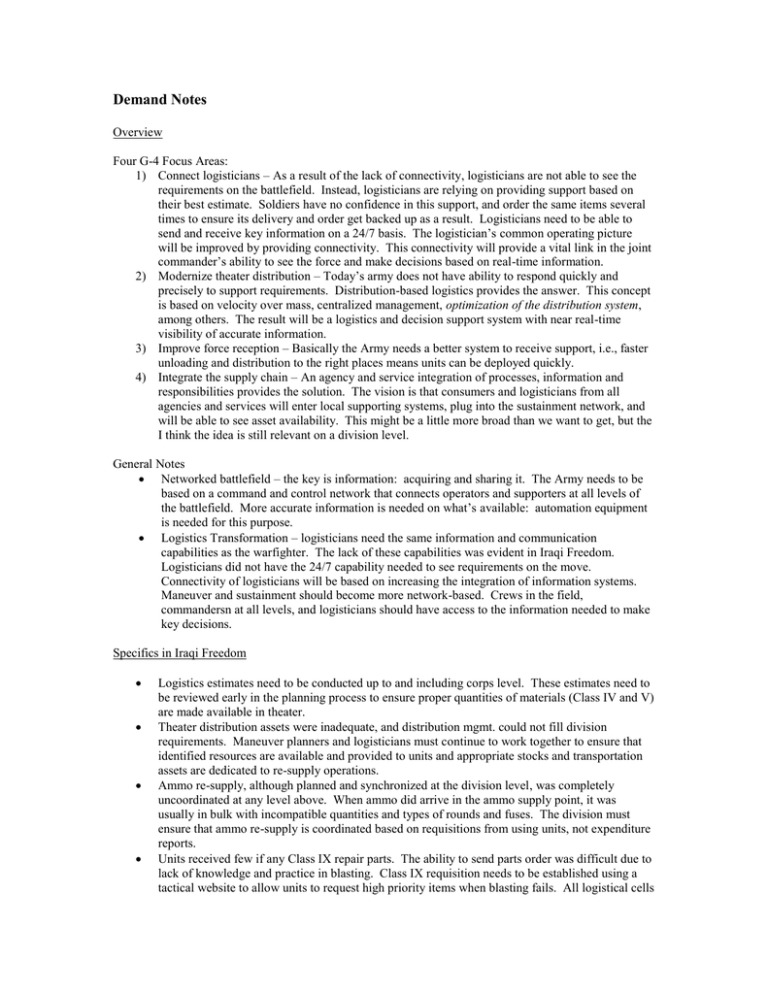Demand Notes.doc: uploaded 27 May 2004 at 6:16 pm
advertisement

Demand Notes Overview Four G-4 Focus Areas: 1) Connect logisticians – As a result of the lack of connectivity, logisticians are not able to see the requirements on the battlefield. Instead, logisticians are relying on providing support based on their best estimate. Soldiers have no confidence in this support, and order the same items several times to ensure its delivery and order get backed up as a result. Logisticians need to be able to send and receive key information on a 24/7 basis. The logistician’s common operating picture will be improved by providing connectivity. This connectivity will provide a vital link in the joint commander’s ability to see the force and make decisions based on real-time information. 2) Modernize theater distribution – Today’s army does not have ability to respond quickly and precisely to support requirements. Distribution-based logistics provides the answer. This concept is based on velocity over mass, centralized management, optimization of the distribution system, among others. The result will be a logistics and decision support system with near real-time visibility of accurate information. 3) Improve force reception – Basically the Army needs a better system to receive support, i.e., faster unloading and distribution to the right places means units can be deployed quickly. 4) Integrate the supply chain – An agency and service integration of processes, information and responsibilities provides the solution. The vision is that consumers and logisticians from all agencies and services will enter local supporting systems, plug into the sustainment network, and will be able to see asset availability. This might be a little more broad than we want to get, but the I think the idea is still relevant on a division level. General Notes Networked battlefield – the key is information: acquiring and sharing it. The Army needs to be based on a command and control network that connects operators and supporters at all levels of the battlefield. More accurate information is needed on what’s available: automation equipment is needed for this purpose. Logistics Transformation – logisticians need the same information and communication capabilities as the warfighter. The lack of these capabilities was evident in Iraqi Freedom. Logisticians did not have the 24/7 capability needed to see requirements on the move. Connectivity of logisticians will be based on increasing the integration of information systems. Maneuver and sustainment should become more network-based. Crews in the field, commandersn at all levels, and logisticians should have access to the information needed to make key decisions. Specifics in Iraqi Freedom Logistics estimates need to be conducted up to and including corps level. These estimates need to be reviewed early in the planning process to ensure proper quantities of materials (Class IV and V) are made available in theater. Theater distribution assets were inadequate, and distribution mgmt. could not fill division requirements. Maneuver planners and logisticians must continue to work together to ensure that identified resources are available and provided to units and appropriate stocks and transportation assets are dedicated to re-supply operations. Ammo re-supply, although planned and synchronized at the division level, was completely uncoordinated at any level above. When ammo did arrive in the ammo supply point, it was usually in bulk with incompatible quantities and types of rounds and fuses. The division must ensure that ammo re-supply is coordinated based on requisitions from using units, not expenditure reports. Units received few if any Class IX repair parts. The ability to send parts order was difficult due to lack of knowledge and practice in blasting. Class IX requisition needs to be established using a tactical website to allow units to request high priority items when blasting fails. All logistical cells should have communication system allowing units to send and receive data. More training and planning is also needed on automation systems for theater support units. These same lessons were learned in Desert Storm. In extended offensive operations, communication systems must be available to call back O2 priority requisitions to the direct support unit and to division Material Mgmt. Center. These communication capabilities allow units to get constant status on requisitions and, if the haul capacity exists, on the consistent flow of Class IX. All logistical nodes need to be outfitted with FBCB 2 and means of voice communication to establish situational awareness needed to project requirements, track forces, and ensure that critical logistics and tactical information is available to all. Lack of in transit visibility had a negative impact on DREAR and DISCOM’s ability to support its division customer base. Corps MCT’s were not properly integrated with corps and theater supply support activities which handicapped their ability to capture and forward in transit visibility information regarding the movement of supplies to the division. The level of training for units and personnel given MTS equipment needs to increase, and the number of MTS systems in the division needs to increase. ORANGE 1 needs to be reestablished as the primary request form. A tactical website-based ORANGE 1 report that can be accessed by all logistical support units to process supply requests needs to be established.




